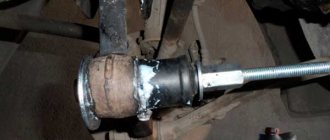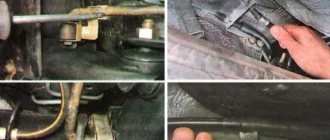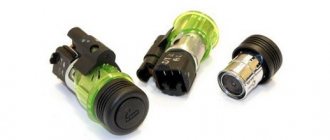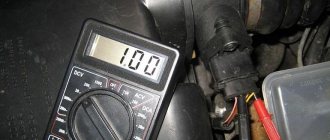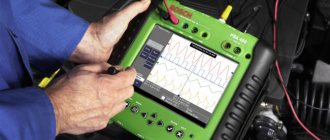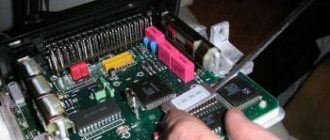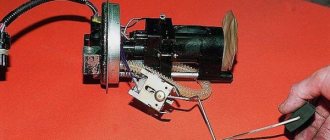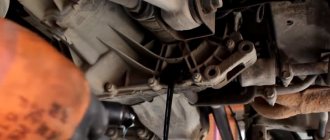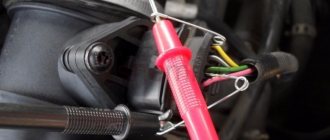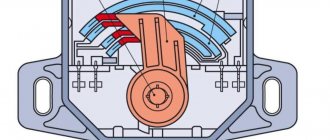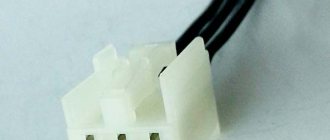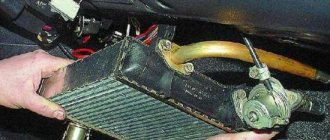For the average motorist, an injection engine is like the Mariana Trench. Everyone knows perfectly well that there is something there, but only great scientists know what exactly and at what depth. In our case, they are large specialists with equipment for computer diagnostics. In a gasoline engine, stuffed with sensors, each of them can in one way or another affect performance, fuel consumption and dynamics. In a word, if something goes wrong, there’s no point in meddling with electronics with a screwdriver. We will have to deal with one of the many sensors today, namely the absolute pressure sensor.
Needed for replacement
Requirements for the ECU (electronic engine control unit):
- ─ January 5.1 2112-1411020-41;
- ─ January 5.1 2111-1411020-61.
A good option is January 7.2. It has free firmware J7ESA, on which you can easily organize DBP. January-5 2111-71,2112-71 and ECUs from BOSCH cannot work with DBP. In this case, it is recommended to replace the ECU (price from 3,000 rubles).
Absolute pressure sensor (DBP or MAP sensor):
- ─ Most often this is a sensor from Gazelle (manufactured in Kaluga), catalog number 45.3829 or 745.3829;
- ─ VW AG 03D906 051 Siemens SME 5WK96930-R (presence of a built-in intake air temperature sensor).
Air temperature sensor (ATS):
Intake air temperature sensor malfunctions
There are several signs of a malfunctioning intake air temperature sensor. Among them:
- interruptions in engine operation at idle (especially in the cold season);
- Engine idle speed is too high or low;
- problems with starting the engine (in severe frosts);
- reduction in engine power;
- excess fuel consumption.
Malfunctions may be due to the following reasons:
- mechanical damage to the sensor caused by exposure to solid particles;
- loss of sensitivity due to contamination (increased inertia of transient processes);
- insufficient voltage in the car's electrical system or poor electrical contacts;
- failure of the sensor signal wiring or its incorrect operation;
- short circuit inside IAT;
- contamination of the sensor contacts.
Checking and cleaning DTVV.
Stories from our readers
“Fucking basin. "
Hi all! My name is Mikhail, now I’ll tell you a story about how I managed to exchange my two-wheeler for a 2010 Camry. It all started with the fact that I began to be wildly irritated by the breakdowns of the two-wheeler, it seemed like nothing serious was broken, but damn it, there were so many little things that really started to irritate me. This is where the idea arose that it was time to change the car to a foreign car. The choice fell on the melting Camry of the tenth years.
Yes, I had matured morally, but financially I just couldn’t handle it. I’ll say right away that I am against loans and taking a car, especially not a new one, on credit is unreasonable. My salary is 24k a month, so collecting 600-700 thousand is almost impossible for me. I started looking for different ways to make money on the Internet. You can’t imagine how many scams there are, what I haven’t tried: sports betting, network marketing, and even the volcano casino, where I successfully lost about 10 thousand ((The only direction in which it seemed to me that I could make money was currency trading on the stock exchange, they call it Forex. But when I started delving into it, I realized that it was very difficult for me. I continued to dig further and came across binary options. The essence is the same as in Forex, but it’s much easier to understand. I started reading forums, studying trading strategies. I tried it on a demo account, then opened a real account. To be honest, I didn’t manage to start earning money right away, until I understood all the mechanics of options, I lost about 3,000 rubles, but as it turned out, it was a precious experience. Now I earn 5-7 thousand rubles a day. I managed to get the car buy after half a year, but in my opinion this is a good result, and it’s not about the car, my life has changed, I naturally quit my job, I have more free time for myself and my family. You’ll laugh, but I work directly on the phone)) If If you want to change your life like me, then here’s what I advise you to do right now: 1. Register on the site 2. Practice on a Demo account (it’s free). 3. As soon as you get something on the Demo account, top up your REAL ACCOUNT and go to REAL MONEY! I also advise you to download the application to your phone, it’s much more convenient to work from your phone. Download here.
- ─ from Niva, catalog number 21214-1413110;
- ─ from Daewoo Nexia 25037223;
- ─ DTOZH VAZ (turbine needs modification).
You will also need:
- ─ Speed sensor connector (for DBP);
- ─ Connector for coolant temperature sensor (for DTV);
- ─ Vacuum hose and tee;
- ─ Wire about 2.5 meters;
- ─ Lyra type terminals.
Firmware for DBP and DTV
After replacing the mass air flow sensor with DBP and DTV, it is necessary to recalibrate the ECU firmware, because For new sensors, different calibrations must be used. Example firmware for ECU Y5.1 without mass air flow sensor: J5LS (J5 Light Sport), J5SPT0005 (J7SPT0005). How to configure firmware for video:
Result : we get high reliability, but an increased delay when pressing the gas pedal. On a naturally aspirated engine, a system with a mass air flow sensor will be more preferable, since it has greater measurement accuracy, and the use of air pressure sensor and air flow sensor on a production engine is impractical. What do you think, is it worth switching from mass air flow sensor to air pressure sensor and air flow sensor on a stock engine without tuning?
Does it make sense to switch from mass air flow sensor to DBP and DTV on an engine without modifications?
Your feedback on the operation of DBP and DTV on a stock engine:
Has the response time of the gas pedal changed when switching to DBP and DTV?
Source
Specialized car radio and features of standards
Before choosing a suitable tuner, you should decide on its standard. Let's compare a digital TV tuner used for a car and a satellite analogue.
| Digital receiver | Satellite |
| Low cost, the car radio is offered at an attractive price. | You can use the receiver anywhere in Russia. |
| Can be used to view all major channels. | Exceptional quality. |
| Ease of setup and versatility. | More channels. |
| Excellent quality, work in several standards at once. | Reliability of operation. |
| Constantly updating the list of broadcast channels. |
It turns out that a car radio with a tuner according to the dvb t2 standard is best suited for use in the city. Digital receiver
It turns out that a car radio with a tuner according to the dvb t2 standard is best suited for use in the city. A car dvb t2 car radio will cost the buyer a small amount, and the set-top box can work with any signal formats.
A set-top box with dvb t2 technology for a car can be used with a signal up to high quality 1080p. In fact, the broadcast occurs in MPEG-2 and MPEG-4. But still, the receiver has a good foundation for the future.
You can purchase a dvb t2 receiver for your car in regular stores. Prices may vary depending on the model and its parameters.
Absolute pressure sensor (MAP-Sensor) on a VAZ
The idea of using DBP (Absolute Pressure Sensor, also known as MAP-Sensor) to estimate the amount of air consumed by the engine instead of the usual mass air flow sensor (MAF) on the domestic injection system January 5 has been floating around for a long time. The root cause is the MAF crisis of 2003 - 2003, when the sensor suddenly became incredibly expensive and scammers, having learned about them from car services, threw a huge amount of counterfeit products onto the market. A wave of thefts of air flow sensors directly from cars has also swept across the country. Many still remember the special lock for the mass air flow sensor (“chastity belt”), which appeared on sale at that time. It was then that an intensive search began for hardware and software solutions for “implanting” DBP on the domestic VAZ injection system.
The advantages of installing a DBP - greater speed, high reliability and unpretentiousness of the MAP sensor - make the modification very attractive. Moreover, many foreign cars are equipped with similar systems as standard. Looking ahead, I will say that, be that as it may, a system with a mass air flow sensor (MAF) on a naturally aspirated engine is more preferable, since it has greater measurement accuracy and the use of MAP on a production engine is impractical. For example, with DBP it is almost impossible to “fit” into EURO-III toxicity standards. And the situation with the mass air flow sensor was smoothly resolved, so it is completely illogical to use “bypass” technology on a production car.
Features and uses
Many people want to watch digital TV in their car. Just a few years ago this was simply not possible, but now it has become a reality. You can easily watch many channels in your car with the help of modern technology. This will be very relevant if you often have to stand in traffic jams and have absolutely nothing to do with yourself at this time.
The dvb t2 standard is great not only for TVs, but also for cars, it was able to show its best side. With its help, you can ensure full reproduction of the digital broadcast system signal and broadcast it to the panel in the vehicle.
To use dvb t2 you will need a specialized tuner for your car. The broadcast is broadcast in an encrypted format, and the device acts as a decoder. It decrypts the transmitted signal using internal protocols, and then transmits it for direct playback on the monitor.
But modern car satellite television will cost a more significant amount. The antenna and tuner are slightly more expensive than for terrestrial digital television reception. The receiver operates in a completely different format; it looks like a standard car radio and is installed in its place. But such a system also has its advantages.
- It is impossible not to note the higher quality of the picture, because such a car radio itself adapts to changes in the reception level and adjusts the main parameters.
- Reception is provided almost throughout the entire country, and you will be able to fully travel out of town.
- Easy to set up equipment.
To switch to DBP you need:
— Absolute pressure sensor, then DBP, a sensor that measures absolute pressure.
Absolute pressure
─ this is the true pressure of liquids, vapors and gases, measured from absolute zero pressure ─ absolute vacuum. It is installed in the after-throttle space of the intake receiver; when the engine is turned off, the readings tend to atmospheric, when idling they tend to vacuum, and when the damper is partially opened, they tend to atmospheric. The sensors differ in the upper value of the measured pressure and, as a result, some are suitable for use only in naturally aspirated engines, some in turbocharged ones. Theoretically, for naturally aspirated engines you can also use those with a turbo, but the mixture compositions will be less accurate, and this is not good; there may be problems with setting the idle speed. Use only the DBP that is needed, do not take it in excess.
— Air temperature sensor
, then DTV, a sensor that measures air temperature. It is a regular thermistor, nothing complicated. Depending on the implementation of air intake, it is installed either in the cold intake air duct, or simply under the hood if the air intake comes from the engine compartment.
— adapter cable from the mass air flow sensor connector to the connectors of the DBP and DTV sensors
The MAF wiring connector can have either four or five contacts; for operation we need five wires. If you have a wiring with four wires, then there is no conductor to the first contact, in which case you will have to lay one wire to the 44th leg of the ECU. If you have five wires on the connector, then you are lucky and you don’t need to do anything additional with the wiring.
You can either buy a ready-made cable or assemble it yourself, it’s nothing complicated, you just need a diagram, a little time to figure it out and the ability to solder.
When switching to DBP and DTV, the following sensors were installed on my car:
— DTV Bosch 0 280 130 039, it has a standard M12 thread, which makes it easy to install.
— DAD Gazelle marking 45.3829
What is an intake air sensor and where is it located?
The intake air temperature sensor (abbreviated as ДТВВ, or IAT in English) is needed to adjust the composition of the fuel mixture supplied to the engine. This is necessary for normal operation of the motor in different temperature conditions. Accordingly, an error in the intake air temperature sensor into the manifold threatens excessive fuel consumption or unstable engine operation.
DTVV is located on the air filter housing or behind it . It depends on the design of the car. It is performed separately or can be part of the mass air flow sensor (MAF).
Places where the intake air temperature sensor is located
Connection diagram for the adapter cable in a convenient form.
To connect to the receiver, I used a fitting and a tube that goes to the DBP, a regular tube for supplying water to windshield washers. Ideally, it should not be long.
At this particular point in time, AvtoVAZ has switched to a system without a mass air flow sensor and uses a pressure and air temperature sensor on engines 21127 and later. A very convenient solution that combines both necessary sensors in one housing, i.e. DBP and DTV; you only need to drill two holes in the receiver, one for mounting the sensor and one for measuring pressure and temperature in the receiver. Articles DADA 127 motor 21800-1413010-00, Delphi 28234360 63521 SNG
Let's look at the pros and cons of an injection system based on mass flow sensor and on the basis of DBP and DTV:
Disadvantages of a system with a mass air flow sensor:
- high cost of the sensor itself - reaction time to changes in air flow is much higher than for DBP, simply put, the brake sensor - almost completely unsuitable for engines with excess pressure due to the small upper measurement range - unstable mixture composition if the mass air flow sensor is moved close to the air pressure sensor , catches pulsations at the inlet
Advantages of a system with a mass air flow sensor:
— direct measurement of air flow, as a result it is difficult to ruin the engine, the mixture will most likely go richer than lean.
Advantages of a system with DBP and DTV:
- smoother idle on camshafts with an evil phase, we will consider the evil phase to be 290 and higher - the cost of a system of DBP and DTV sensors is three times cheaper - hello, sharp response to the gas pedal, the engine runs more elastic, very fast air calculation
- there are no large measuring elements in the intake system, and there is no mass air flow sensor mesh which serves to smooth the flow and which cannot be removed, as a result the engine produces a little more power - suitable for supercharged engines
Symptoms of DBP malfunction
If the absolute pressure sensor (also called MAP sensor, Manifold Absolute Pressure) fails completely or partially, the failure appears externally in the following situations:
- High fuel consumption. This is due to the fact that the sensor transmits incorrect data on the air pressure in the intake manifold to the ECU, and accordingly, the control unit issues a command to supply more fuel than necessary.
- Reduced engine power. This manifests itself in poor acceleration and insufficient traction when driving the car uphill and/or when loaded.
- There is a persistent smell of gasoline in the throttle valve area. This is due to the fact that it is constantly overflowing.
- Unstable idle speed. Their value either falls or rises without pressing the accelerator pedal, and while driving, kicks are felt and the car twitches.
- Engine “dips” during transient conditions, in particular, when changing gears, starting the car, or changing the throttle.
- Problems starting the engine. Moreover, both “hot” and “cold”.
- Formation of errors in the memory of the electronic control unit with codes p0105, p0106, p0107, p0108 and p0109.
Most of the troubleshooting symptoms described are general and can be caused by other reasons. Therefore, it is always necessary to perform comprehensive diagnostics, and you need to start, first of all, by scanning errors in the ECU.
Signs and causes of malfunction
For timely detection of problems associated with both the sensor itself and the operation of the air supply system. The most common symptoms of a faulty temperature sensor are:
- The internal combustion engine does not start well in conditions of low ambient temperature;
- The engine malfunctions at idle;
- Noticeable excess of fuel consumption;
- There are noticeable interruptions in the operation of the motor;
- Turn on the indicator lights on the dashboard or display a message on the on-board computer.
The cause of such factors can be various malfunctions, both in the sensor itself and in the accompanying elements of the air supply system. Among the reasons that motorists often identify are:
- Short circuit in the sensor circuit;
- Oxidation of contacts, which makes a noticeable correction to the measured value;
- Clogged sensor element - dust particles can circulate through the system along with the intake air and settle in the thermistor area;
- Mechanical damage to the housing or other auxiliary elements, which affects the accuracy of measurements;
- Open circuit in the sensor measuring circuit.
Also note that the reason may be a clogged filter and a deterioration in the permeability of the system. But to determine a specific malfunction, it is necessary to carry out diagnostics.
How does an absolute pressure sensor work?
Before checking the absolute air pressure sensor, it is necessary to understand in general terms its structure and operating principle. This will facilitate the verification process itself and the accuracy of the result.
Thus, in the sensor body there is a vacuum chamber with a strain gauge (a resistor that changes its electrical resistance depending on the deformation) and a membrane, which are connected via a bridge connection to the electrical circuit of the car (roughly speaking, to the electronic control unit, ECU). As a result of engine operation, air pressure changes, which is recorded by a membrane and compared with vacuum (hence the name - “absolute” pressure sensor). Information about pressure changes is transmitted to the ECU, on the basis of which the control unit makes a decision on the amount of fuel supplied to form the optimal air-fuel mixture. The full sensor operation cycle looks like this:
- Under the influence of pressure differences, the membrane is deformed.
- The specified deformation of the membrane is recorded by a strain gauge.
- Using a bridge connection, the variable resistance is converted into a variable voltage, which is transmitted to the electronic control unit.
- Based on the information received, the ECU adjusts the amount of fuel supplied to the injectors.
Modern absolute pressure sensors are connected to the ECU using three wires - power, ground and signal wire. Accordingly, the essence of the test often comes down to using a multimeter to check the resistance and voltage on the specified wires under various operating conditions of the engine in general and the sensor in particular. Some MAP sensors have four wires. In addition to the above three wires, they add a fourth, through which information about the air temperature in the intake manifold is transmitted.
In most cars, the absolute pressure sensor is located directly on the intake manifold fitting. On older vehicles, it may be located on flexible air lines and attached to the vehicle body. When tuning a turbocharged engine, the DBP is often located on the air ducts.
If the pressure in the intake manifold is low, then the signal voltage produced by the sensor will also be low, and vice versa, as the pressure increases, the output voltage, transmitted as a signal from the DBP to the ECU, also increases. So, with the damper fully open, that is, at low pressure (approximately 20 kPa, differs for different machines), the signal voltage value will be within 1...1.5 Volts. With the damper closed, that is, at high pressure (about 110 kPa and above), the corresponding voltage value will be 4.6...4.8 Volts.
Operating principle and design of the device
The design of the device includes two chambers - vacuum and atmospheric. It is clear that the first chamber contains a vacuum, and the second chamber is directly connected to the intake manifold. In addition, the device body contains four strain gauges, which are attached to the diaphragm, and a silicon chip. Pressure acts on the diaphragm, and under its action it moves the sensitive elements, changing their resistance, as a result of which the silicon chip supplies a pulse of a certain value to the ECU. The strain gauges are connected in a bridge circuit to increase the impulse, and the voltage across the sensor can vary from one to five volts.
It is on the basis of the received voltage that the electronic control unit draws a conclusion about the pressure in the intake manifold. Higher pressure means higher voltage and vice versa. Depending on the design of the sensor, it can supply both an analog and digital signal, but for this it is necessary to integrate a special analog-to-digital signal converter circuit into the sensor body.
Checking the DBP sensor
Checking the absolute pressure sensor in the manifold comes down to the fact that you first need to make sure that it is clean, and therefore sensitive to changes in air flow, and then find out its resistance and the output voltage when the engine is running.
Cleaning the absolute pressure sensor
Please note that as a result of its operation, the absolute pressure sensor gradually becomes clogged with dirt, which blocks the normal operation of the membrane, which can cause partial failure of the DBP. Therefore, before checking the sensor, it must be removed and cleaned.
To clean, the sensor must be removed from its mounting location. Depending on the make and model of the vehicle, mounting methods and location will vary. Turbocharged engines typically have two MAP sensors, one in the intake manifold and one on the turbo. Typically the sensor is secured using one or two mounting bolts.
Cleaning the sensor must be done carefully, using special carb cleaners or similar cleaning agents. During the cleaning process, you need to clean its body, as well as the contacts. In this case, it is important not to damage the o-ring, contact elements of the housing and the membrane. You just need to spray a small amount of cleaning product inside and pour it back along with the dirt.
What is an intake air sensor
The control system uses data received from the DTVV to estimate air density and balance the air mixture.
Cold air has a higher density, and therefore maintaining the proportions of the air-fuel mixture will require the use of the required amount of fuel. The device is located separately behind the air filter and is integrated into the mass air flow sensor. The location depends on the design features of the individual vehicle.
Purpose and principle of operation
DTVV consists of a semiconductor element (in our case, a thermistor), which has an inverse dependence of the resistance value on temperature indicators. If translated into more understandable language, an increase in temperature leads to a decrease in electrical resistance and vice versa.
What should the battery density be and how to increase it if necessary - see here.
In our material you will find information about Litol 24 analogues and their features.
The principle of operation is to compare the resistance and voltage values and calculate the temperature. The electronic system control unit analyzes the received information about the above-mentioned values, which depend on temperature indicators. It is calculated, after which the engine operation is adjusted.
How and when to check
Diagnostics is performed on the principle of proportional changes in voltage and outgoing electrical signals.
So, where does the check begin:
- We calculate the resistance - remove the sensor, disconnect the two wires and take a measurement using a multimeter. For clarity, measurements are taken in two engine operating modes - “cold” and at full speed.
The first measurement will show high-resistance resistance, in the second case - low-resistance. The attached instructions must have a table of the dependence of resistance on temperature. Large deviations clearly indicate a malfunction of the semiconductor device.
- Checking the serviceability of the wiring connections - the tester checks each contact, for which a multimeter is connected to the sensor connectors and the control unit is disconnected. The resulting result must be zero.
- Measuring supply voltage - the signal value must completely coincide with the passport data of the individual device. The vehicle is pre-ignited.
The intake air temperature sensor is semiconductor, so it cannot be adjusted. All available manipulations will fit in one line: cleaning contacts, checking the electrical signal, replacing.
Causes and symptoms of malfunctions
First, let's look at the signs of malfunctions:
- Problematic start at low temperatures;
- Reduced engine power characteristics;
- Increased fuel consumption;
- Deviations in idle speed;
- “Intermittent” engine operation;
